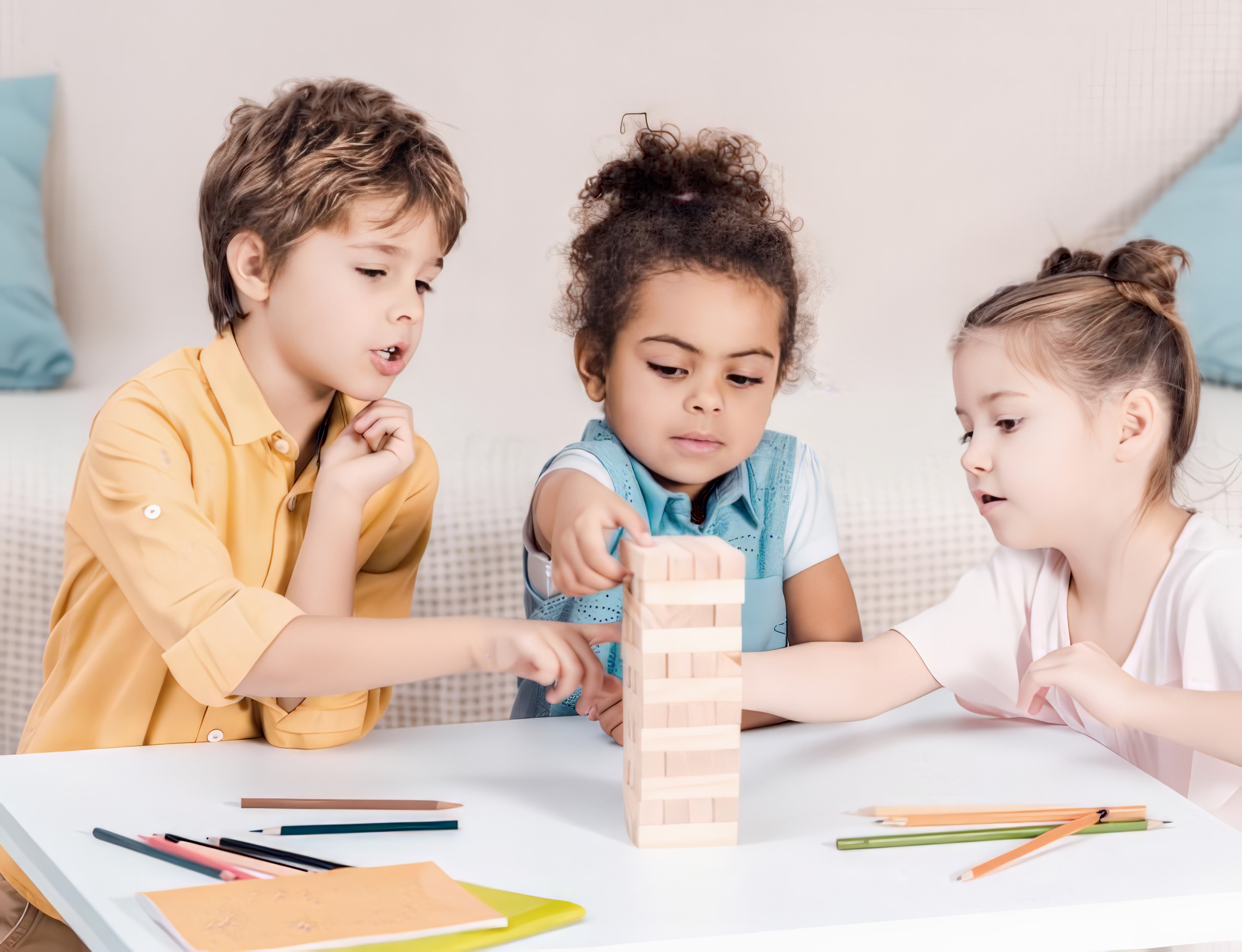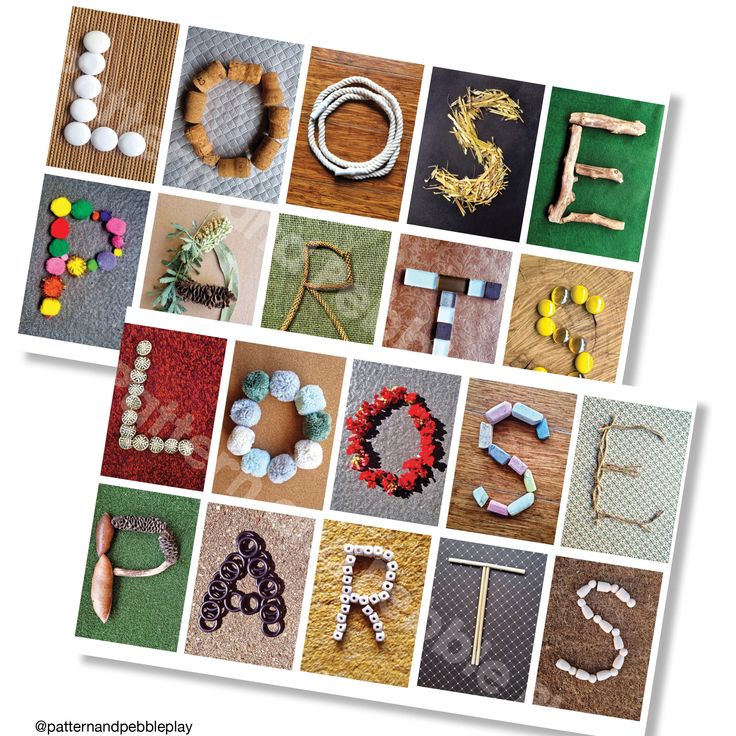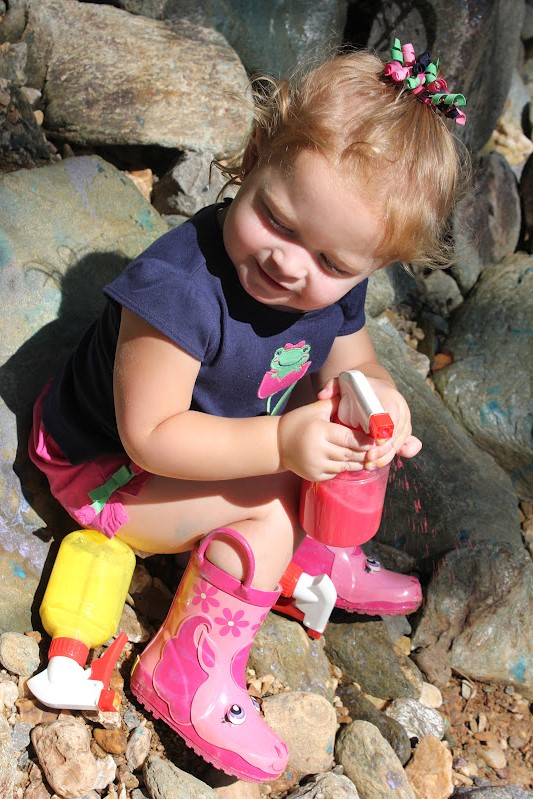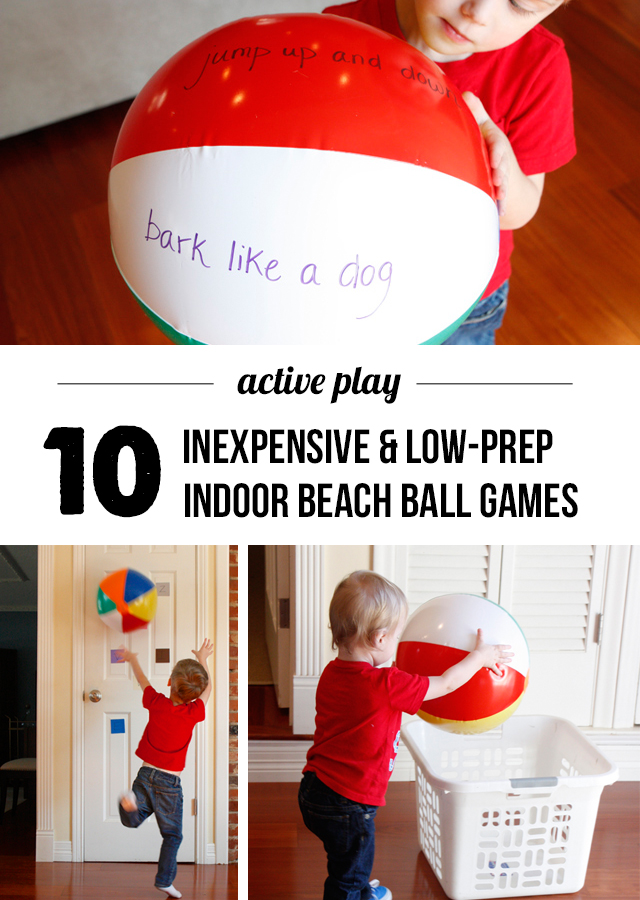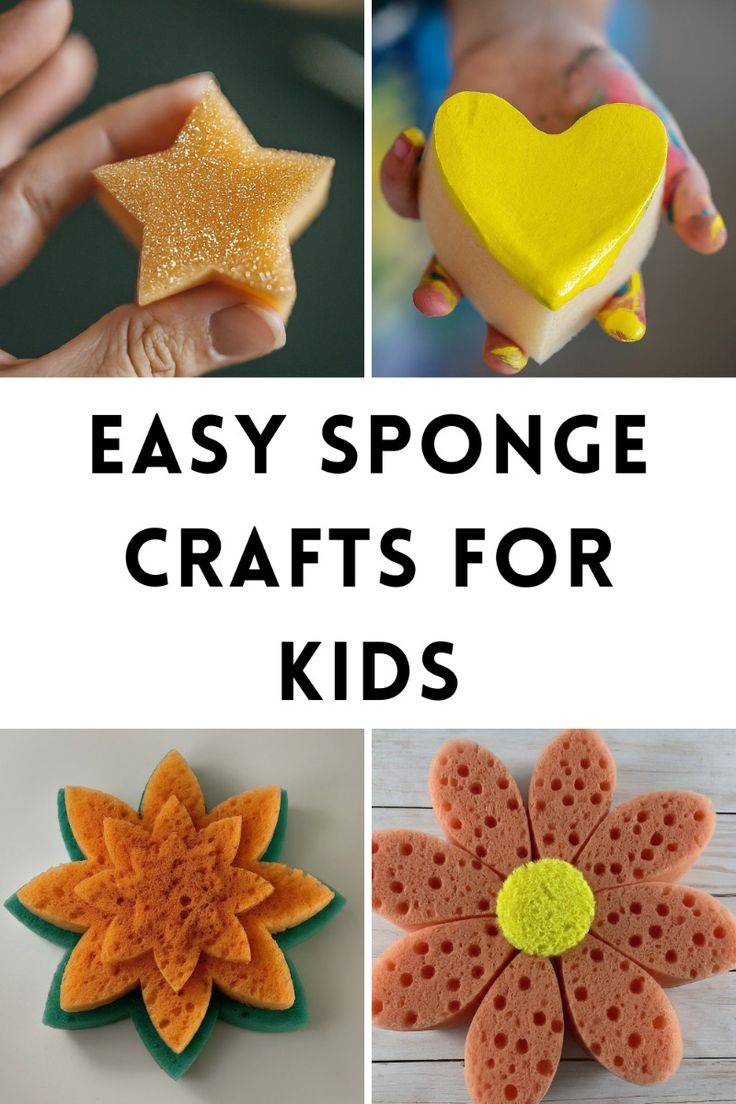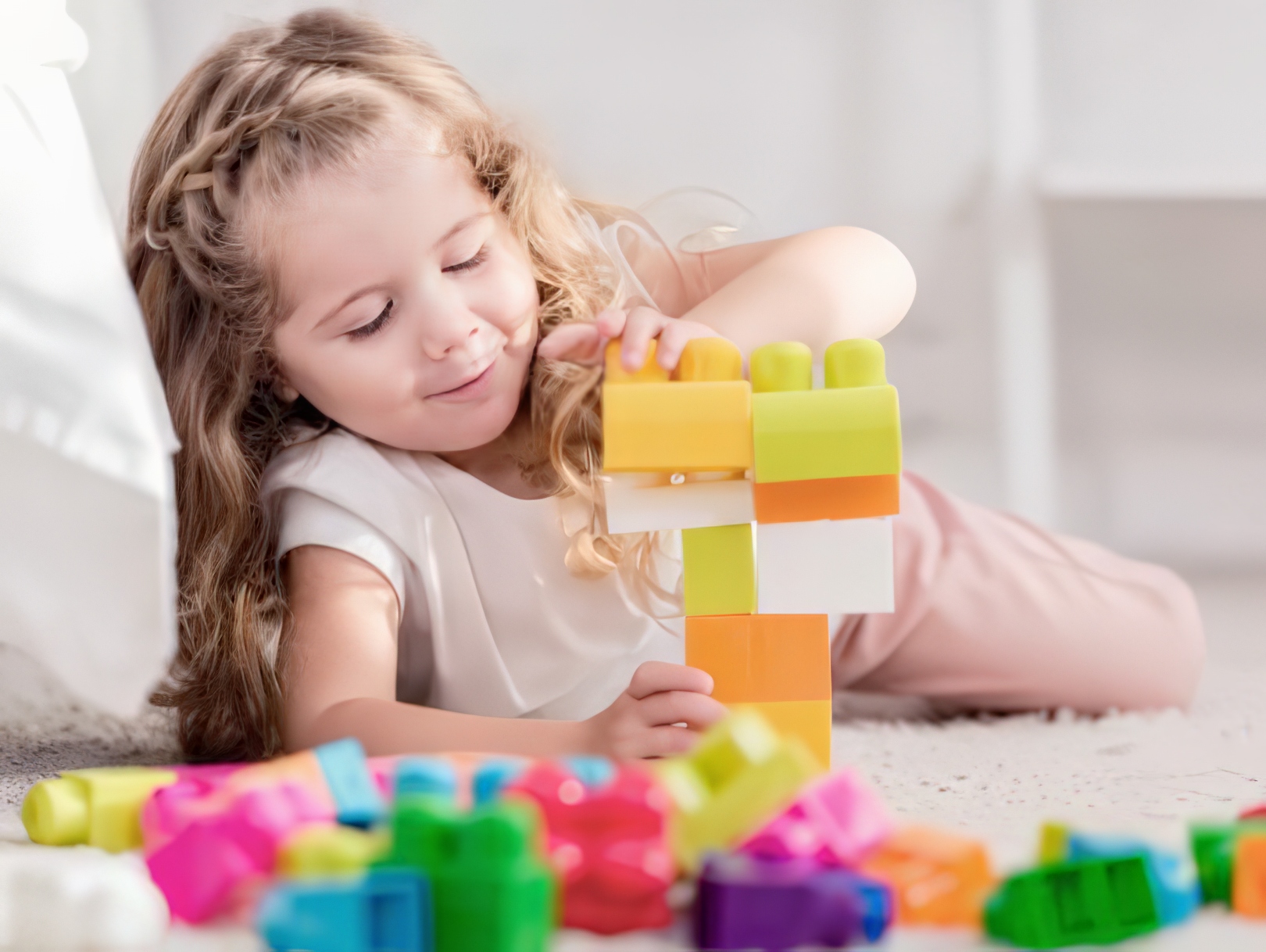Loose Parts Activities and Resources for Babies toddlers Children
Tinkering with Loose Parts
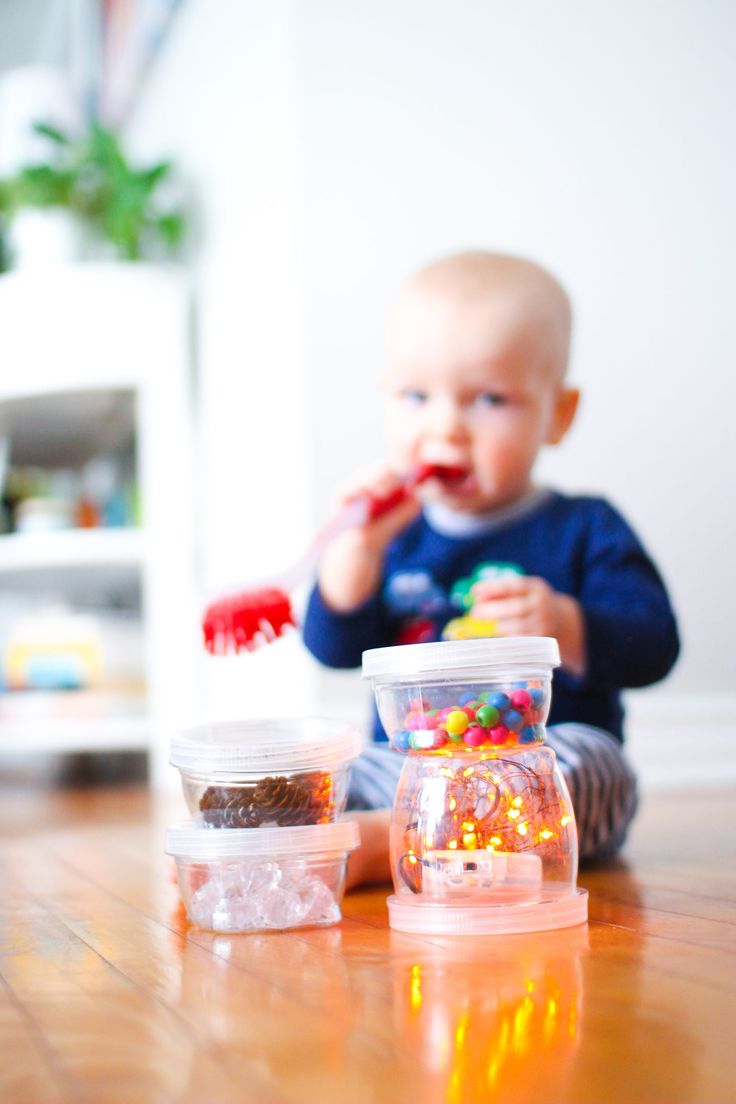
Babies and toddlers can get involved in a wide range of loose parts play and learning. One of the beauties of loose parts play is that children can access it more or less from birth. There are so many more options for entertaining toddlers and kids in general when they can explore the outdoors.
Today, I want to share some of those options with you. I first became acquainted with the term ”loose parts” -from a Reggio Facebook group. Loose parts, architect Simon Nicholson argued, let kids engage in open ended, experimental play. These parts can be used to build, be taken apart, carried around, and used to build something totally new and different. They are the ultimate open ended toy.
The introduction of loose parts to a setting can inspire a whole host of learning and play possibilities. As loose parts are open ended, they offer children the freedom of expression and the ability to be creative. Babies are pre-programed for exploratory play with just about anything that they can reach. However, what they don't come with a sense of danger. So we try to present various baby safe loose parts in containers.
Sky, my granddaughter, was just here for a week. I put her toys in thematic categories in plastic bins with lids before she arrived just as I did for her mom. However, she was more interested in the world around her and finding things to play with on her own. I love watching them find interesting ways to inspect and play with just about anything. However, it was a reminder that children will play with anything that catches their attention. And trying to direct their play won't be necessarily welcomed or even wanted.
What is expected is to make sure that what they want to play with is safe and full of sensory input so they become fascinated with the selection that we have made available for them to play with. One week they may be into interacting with squishy or shiny things and the next they are into things that they can make noise with. So variety is often the key to success in loose parts play for any age child.
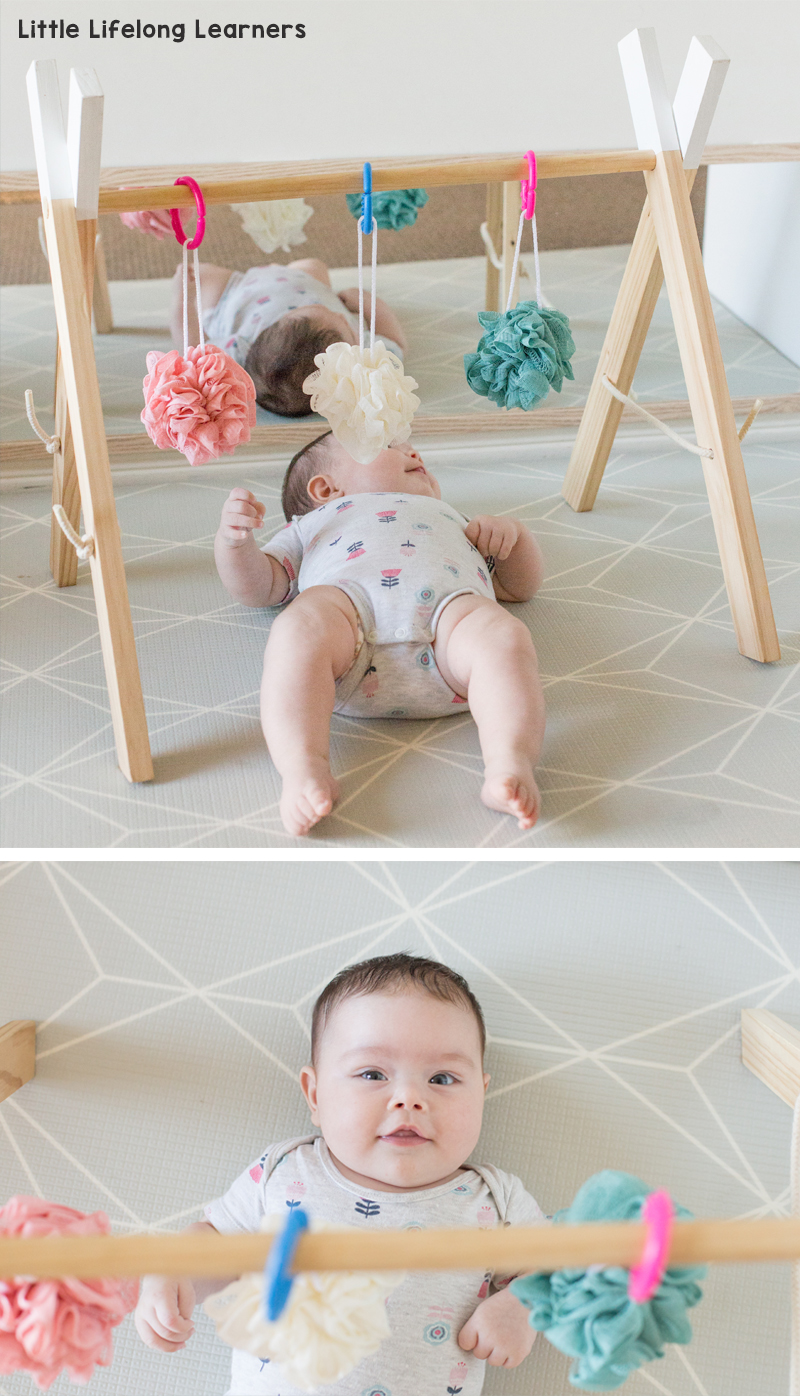
Loose parts play supports many skills in early childhood education including:
Independence – It supports children in developing their own ideas, and having a sense of autonomy over their learning
Imagination – Children develop ideas, narratives, stories and more
Total engagement – They can often be found in a state of pure involvement which is a brilliant state of learning to be in
They can experiment with and explore the world around them through familiarizing themselves with its parts or objects through their sensory systems and h
They begin to make sense of the world
CREATING A LOOSE PARTS DISCOVERY BASKET FOR BABY
Creating a loose parts sensory basket saves time, space, and valuable parental energy. I want to make this area of play accessible and easy to understand because it’s one of the best learning opportunities you can offer to your baby. Let’s break this down in the simplest way possible so you can get started with some loose parts sensory fun with your kiddo.
Creating a loose parts discovery basket saves time, space, and valuable parental energy. Engaging your baby in sensory play doesn’t have to be an elaborate activity.
Creating a basket of loose parts for baby to explore makes new and interesting objects easily accessible to our babies.
The items in the basket are meant to excite the senses (sounds fairly obvious, doesn’t it). This includes activities and objects that will stimulate baby’s sense of hearing, touch, smell, and taste. Also included are the often ignored sense of balance and body awareness (known as proprioception for the fancy science types). This is how children learn to make sense of the world around them. As humans, we retain information more efficiently when we engage with our senses. Sensory play helps the brain create strong connections through problem-solving and exploration.
Loose parts aren’t really toys, they’re things. They’re items from nature, stuff you have lying around the house, and even things from the recycling bin. Metal bowls, silicone pot holders, a plastic water bottle filled with beans, a silicone dish scrubber, pine cones, or a whisk from the kitchen drawer. This kind of play provides baby with opportunities to mouth, touch, bang together, manipulate, observe, and rearrange objects.
If you’ve ever given your baby toys only to witness them reaching for the coaster on the coffee table a moment later it’s because they’re naturally interested in everyday objects as a way of making sense of their environment. Remember that to baby, everything is new and interesting, even a spatula.
Making a loose parts basket that engages your baby in sensory play is ideal because you’re picking and choosing which everyday objects you’re willing to let baby explore in a safe and supervised way.
Benefits of Treasure Baskets
Researchers have found many benefits from using treasure baskets, and it is one of the central resources to use with children of this age. You can find more of the huge number of benefits of this type of play in this article. Some excellent features include some of the following:
Children develop concentration. Often babies can interact with a basket for an quite amazing length of time.
They develop curiosity. This quality of curiosity is one of the central motivators for learning, as well as being important for living a happy and fulfilling life.
They begin to make decisions for themselves. It is completely up to them which loose part object they select. It is also up to them what they do with it.
A good activity to practice sitting. If children are thoroughly engaged in an activity with a treasure basket, they will develop their muscles and balance by sitting up for a prolonged time period.
They learn to experiment and begin to make hypotheses about reality.
Some of these benefits, such as curiosity, really do underpin all learning. Curiosity is something that we promote in all of our online courses (that you can check out here).
Top Tips For Using Treasure Baskets
Let them explore. Don’t interfere in the learning unless you need to.
Think of yourself as a facilitator rather than a teacher.
Use a shallow basket that is easy to access for the child, so they can take things out of it.
WHY SHOULD I INTRODUCE LOOSE PARTS PLAY ACTIVITIES TO MY BABY?
In terms of learning, here’s the beautiful thing about this kind of play and why I am such an advocate for it as an educator and parent. It doesn’t get boring. It never gets old. They never tire of it because it’s easy to change up. Sounds magical if you’re a mom to a little one with boundless energy and a need for stimulation. Am I right?
Why is sensory play so magical? Simply because the items and objects involved are open-ended and do not have a distinct purpose for play. Take a whisk for example. Baby can put his/her fingers in between the loops, can bang it by the handle or by the end (making two completely different sounds), can stick his/her tongue into it, can chew on the end of it, can roll it, can throw it, and can even try to pull pom poms out of it. All this at a few months old! Just wait until they’re older and the very same whisk becomes a magic wand, a scepter, or a guitar.
To use loose parts for babies, start with a few large, safe, textured items in a treasure basket
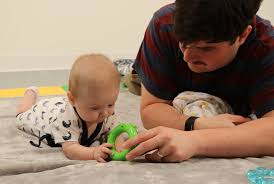
To introduce a baby to loose parts during tummy time or floor play, start with a few larger, age-appropriate items with varied textures like large wooden rings, smooth rocks, or fabric scraps. Place them in a defined, uncluttered space, such as a blanket, and allow the baby to explore independently while you stay nearby to supervise. Voluntary grasping skills starts to develop at five to eight months.
During tummy time
Start with a few items: Avoid overwhelming the baby by offering just 3–5 different items at a time.
Choose large, safe parts: Select loose parts that are too big to be a choking hazard, such as smooth, large stones or wooden blocks.
Vary textures: Include materials with different sensory experiences, like smooth wood, rough pinecones, or soft fabric scraps.
Provide a defined space: Set up a play area on a blanket or mat to clearly define the play space.
Stay nearby: Sit close by as a quiet presence, allowing your baby to practice their skills independently.
Offer encouragement: Gently encourage your baby to look both ways to develop balanced neck muscles.
Support their head position: If your baby is new to tummy time, you can prop them up with a rolled towel under their chest to make it easier for them to lift their head and look around.
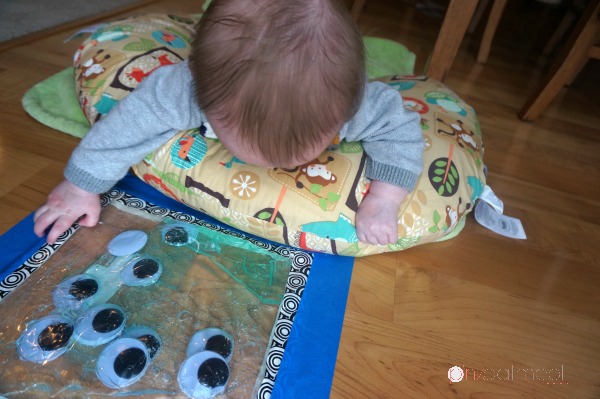
Transitioning to older babies and floor play
Gradually increase variety: As your baby gets older, you can slowly add more items, like different sizes of blocks, cups, or balls.
Introduce a shallow tray or dish: Placing loose parts in a shallow container can entice your baby to start exploring them.
Add familiar items: Include items your child already loves, like a favorite doll, and place the loose parts around it.
Introduce new concepts: Use loose parts to encourage new skills, such as a small mirror to help with object permanence, or cups for practicing pouring water or other safe, soft materials.
Involve your baby: As your baby becomes more mobile, involve them in collecting new loose parts, like sticks or large leaves, to add to their play collection.
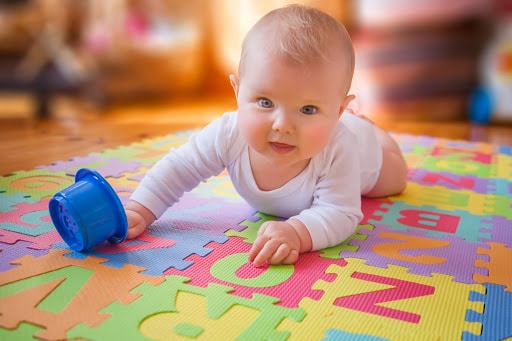
When incorporating loose parts for infants into your environment consider appropriate items that invite action and opportunity for babies to touch, mouth, explore, move, bang, and rearrange. Examples include balls, knotted cloth napkins, hair rollers, and bracelets.
For toddlers, select items that they may transform, transport, and construct. When a toddler plays with a plastic apple it is always an apple, but when she plays with a pinecone she may choose for it to represent an apple, a tree, or a ball for rolling—anything that she imagines.
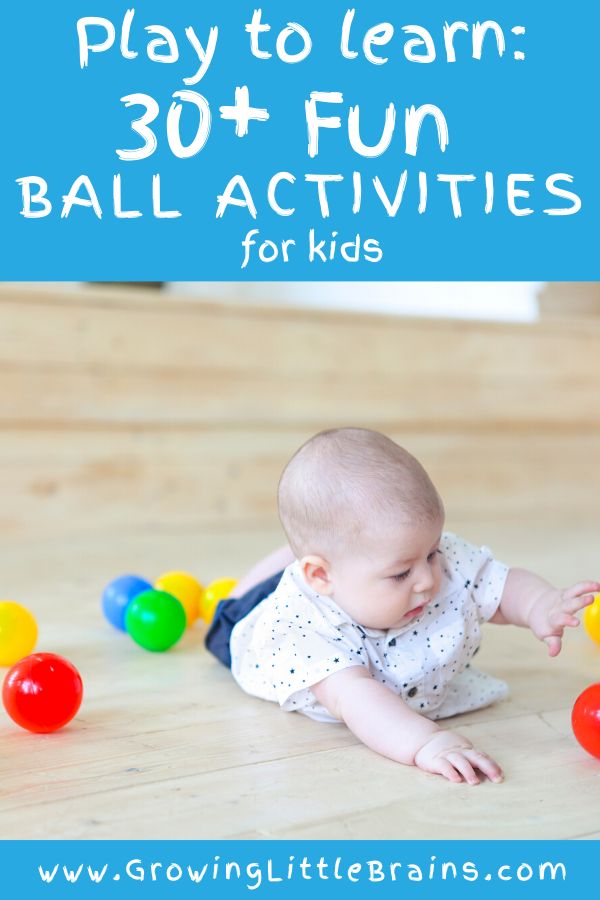
How to engage your baby with ball play
Allow babies to explore with their hands, feet, mouth (make sure you choose toys that are safe to chew).
Roll the ball back and forth on the floor.
For older babies, hide the ball under a blanket and see if your baby will move to try to find it.
Hold the ball 8-12 inches from babies face and move slowly up/down/right/left and in circles to see if your baby can follow the ball with their eyes.
Roll a textured ball on baby’s arms, legs, back, hands, and feet for sensory input.
More ball activities to try with older baby
Try Tummy time on the floor and roll the ball in front of them to distract and encourage them to lift their head using the back and neck muscles. Or perhaps sit them up and get someone to pass the ball towards them and away. You could even move it around infant of them or toss it in the air. These gentle moves all aid eye tracking and focus skills.
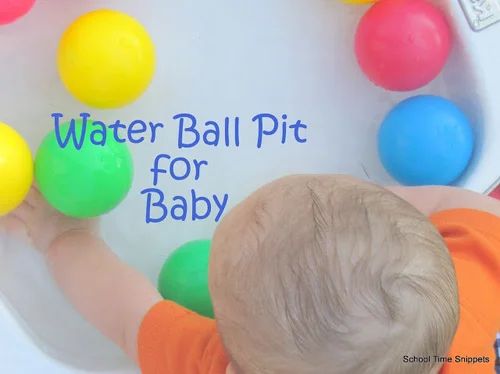

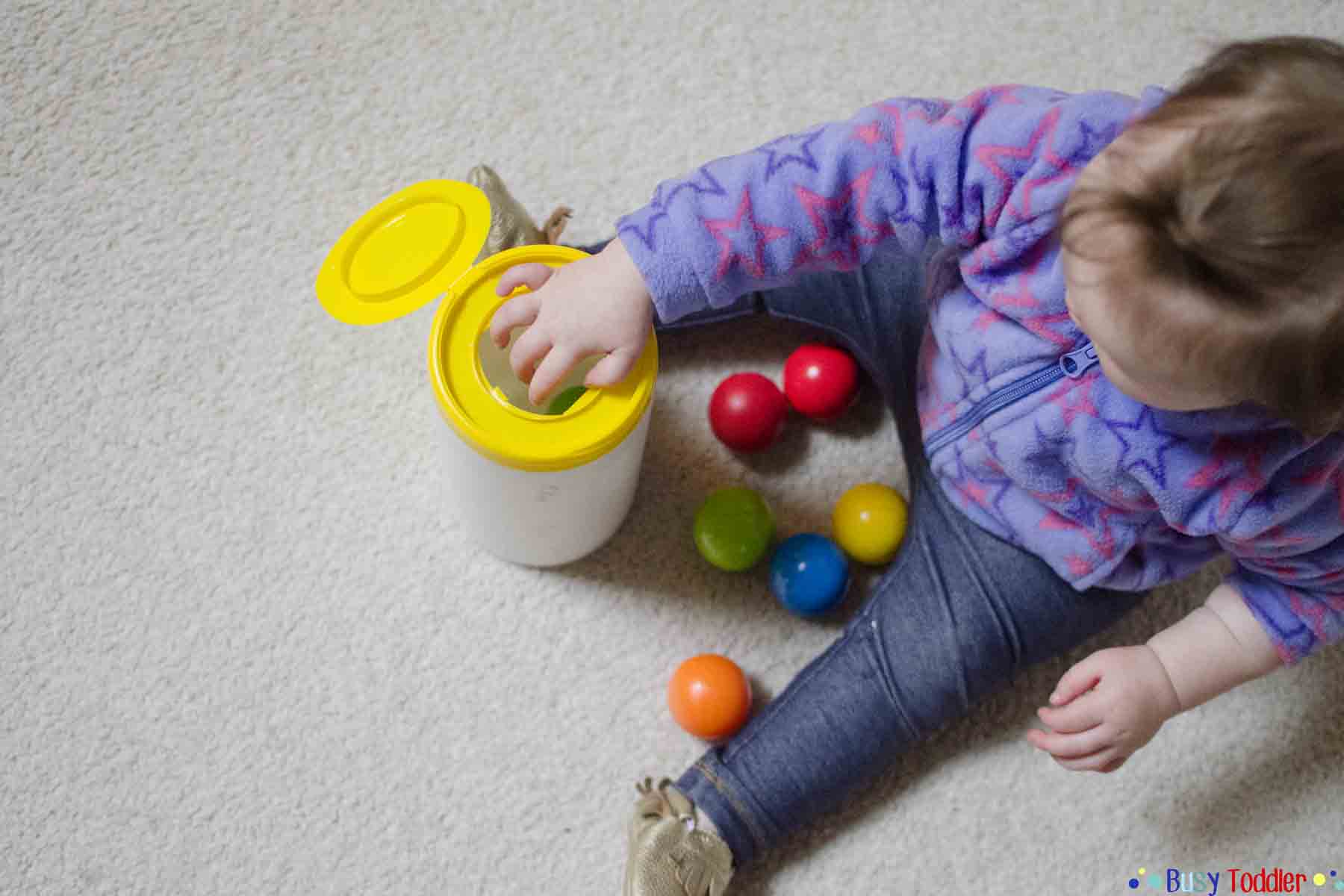
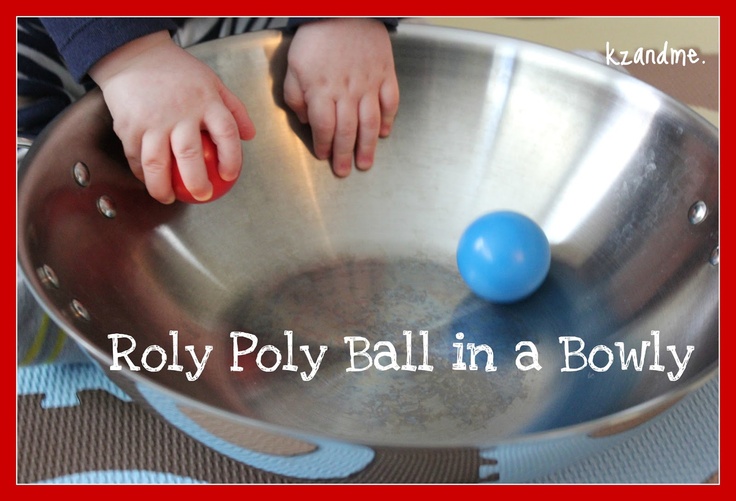
Infants and toddlers learn heuristically, that is through investigating, discovering, or problem solving by experimental and trial-and-error methods. Therefore, it is important for teachers and caregivers to provide open-ended materials (loose parts) that allow infants and toddlers opportunity to explore their properties and functions through their sensory system.
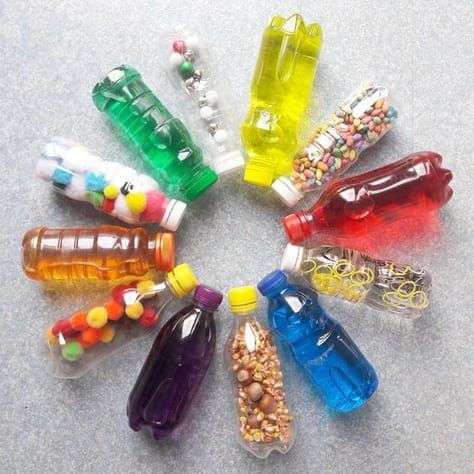
Children of all ages, abilities, skill levels, and genders can use loose parts successfully. Because there’s no right or wrong way to work with these items, infants and toddlers may use them according to their ability and interest. For example, a young infant may look at, feel, grasp, and mouth a large, polished tile sample; a mobile infant may stack the tiles; and an older toddler may fill a bucket with them and then dump them out.
Interacting with any loose parts become significant and visible as caregivers thoughtfully observe children’s engagement with materials, reflect on the importance of the interactions, and respectfully respond to children’s intentions.
Focus on providing a variety of materials like fabrics, large wooden rings, silicone cups, or smooth natural objects like large stones, ensuring everything is too big to swallow and has no sharp edges. Supervision is essential, and you can expand by introducing a few more items at a time as the baby shows interest.
This video demonstrates how to set up and use loose parts for infants and toddlers:
Cultivating Confidence - Early Years Consultancy YouTube
Getting started
Start small: Offer only 3-5 large, safe, and varied items at a time to avoid overwhelming the baby.
Prioritize safety: Only use items that are too large to be a choking hazard and have no sharp edges.
Focus on sensory experience: Provide items with different textures, weights, and shapes to encourage sensory exploration.
Begin with tummy time: Use loose parts to make tummy time more engaging. Place them in front of the baby and let them explore with their hands, eyes, and mouth (under supervision).
Examples of suitable loose parts for babies
Textiles: Large scraps of different fabrics like silk, velvet, or cotton, soft brushes, or large play silks.
Household items: Silicone baking cups, large metal or wooden spoons, large plastic lids, or cardboard tubes.
Natural items: Smooth, large stones, large pinecones, or driftwood (ensure they are clean and free of small parts).
Rings: Large wooden rings or canning rings.
This video provides more examples of loose parts play:
Western International School of Shanghai (WISS)YouTube
Important considerations
Rotate materials: Keep the play interesting by swapping out items in the basket periodically.
Supervise closely: Always supervise your baby while they are playing with loose parts to ensure their safety.
Let them discover on their own: Allow the baby to lead the play. They will find their own uses for the items, whether that's grasping, shaking, or simply exploring the textures.
Avoid small objects: Do not give infants and toddlers small items like beads, buttons, or small shells, as they pose a serious choking risk. I use
WHICH LOOSE PARTS ITEMS SHOULD I GATHER?
Loose parts sensory play offers unlimited learning opportunities for all children and can easily be adapted depending on age and ability. The materials provided, and how you offer them, is highly age-dependent. If you have an infant who puts everything into their mouths consider how you can house smaller objects that may be a choking hazard so baby can still explore them without concern. I use water bottles, tins, and clear plastic containers for this. For example, pebbles and beads can be placed within a container for infants, but are fine for older children to play with freely.
If you have an infant who puts everything into their mouths consider how you can house smaller objects that may be a choking hazard so baby can still explore them without concern. You can offer loose parts to baby safely by housing small items within clear plastic containers, tins, and bottles. I always use the example of a matchbox car being the size that we can safely hand to a baby. Anything small than a matchbox car can be put inside a sealed ziplock bag, container or bottle then present the baby safe option in your baskets or play area.
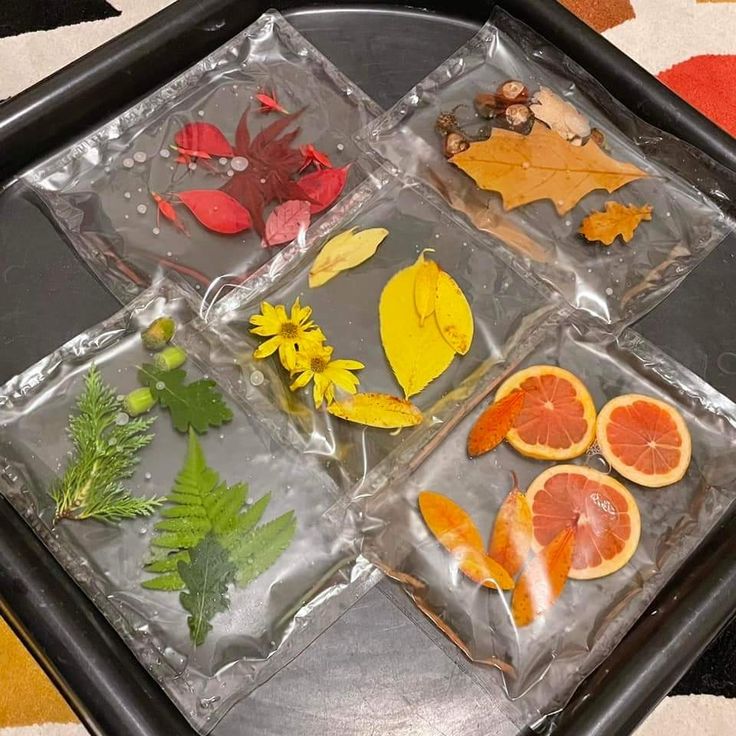
More Ways to Introduce Natures Many Loose Parts Inside
Let them help be a part of the whole process of collecting and assembling and then investigating nature inside your homeif they are able
Nature Sensory Bottles
These were a real treat in our house. Simply choose which sense you’re going to activate and fill small clear jars with either flowers (sight), herbs (smell), grains (hearing) or anything that will surprise your little one! I used empty spice jars or plastic jars from Dollar Tree. The grains were a big hit as they made lovely gentle sounds, which she preferred over loud, synthetic commercial ones. I used smaller spice jars when the kids were babies. Fill bottles with water and your natural treasures and tighten the cap securely
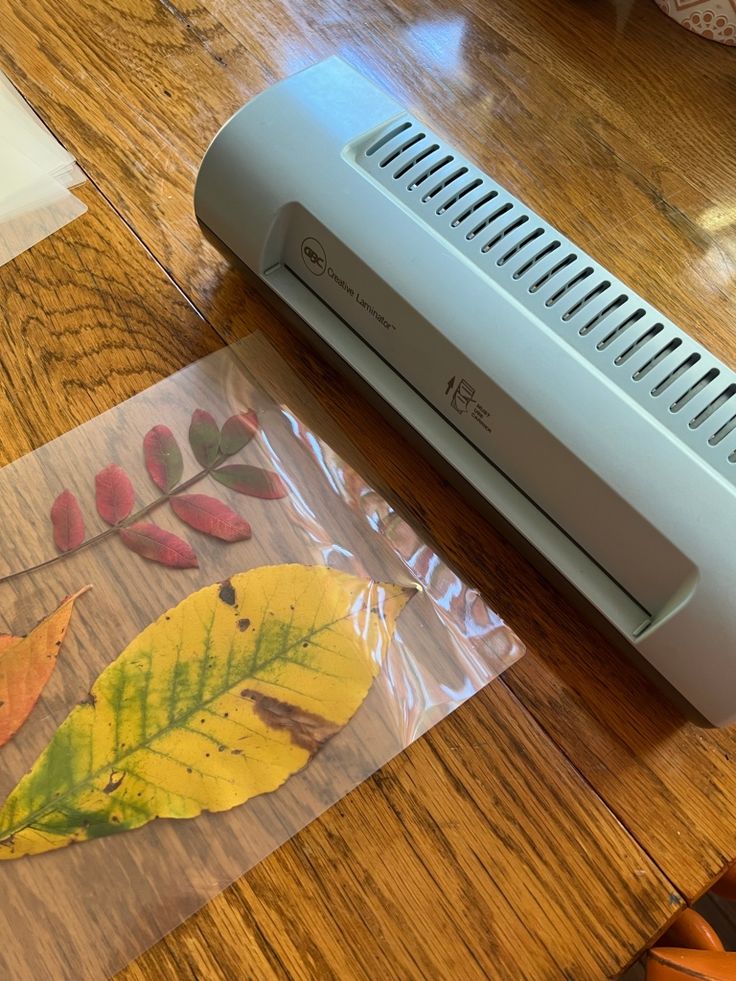
Laminated Leaves & Flowers
Simply trim the stem off a few wild flowers and have them put in a laminator pouch then run them through the laminator or press them in a heavy book for a few days then use clear contact paper on both sides of the flowers. I cut all my sheets to the same size to make it easier for children to sort through. She really enjoyed studying each little bud and leaf.
The girls made theirs into a suncatcher garland & loved exploring the flowers with magnifying glasses and comparing the flowers and leaves. Beautiful right? I love spring crafts because they bring so much color into the house!
Baby Nature Blocks
Hope was a happy baby who loves simple games like that (as do most babies. Blinking lights and flashy toys are really not necessary!)
But sometimes mama just wants to get crafty and make a new toy for baby. I did that today with a grocery store bouquet of flowers and some upcycled baby food containers!
How to Make Baby Nature Blocks for Discovery Play Baskets
First off, this is going to be the easiest toy to make! I barely need to make a “how to” section on this post. But I know how much some of you like details, so here goes:
Supplies:
Flowers (I used a grocery store bouquet) or other nature
Baby food containers (Gerber’s plastic ones work well)
After the food containers were empty and had been washed, I just placed a few flowers and leaves inside of them and snapped the lid back on. That’s it. The hardest part of this whole activity is having flowers on hand.
The next step was introducing them to baby. He was soooo happy! He knocked over every tower I made, threw them across his mat, investigated them from all angles, banged them together, etc.
These blocks are so inviting! The way the light shone through them, the vibrant colors of the flowers, and the way the petals gently swished as he shook them made them extra intriguing for our little guy <3
I know some of you will ask how long these blocks keep for. The truth is I don’t know. We just made them yesterday, so I’ll test them out and update you all later.
Sound blocks can be made with the same process. The eight sound blocks I made were filled with nature, rice, beans, pasta, birdseed, shells, pea gravel, beads, and colored gems. You could use any materials you have on hand though that you feel would make a neat noise when shaken. I think next I’d like to make one with bells inside
Nature Sticky Mural
Nature is art, and you can also create your own custom art with elements from nature! I can Teach my Child has a lovely idea for an outdoor mural where toddlers can stick leaves, petals and whole flowers in any pattern of their choice. You’ll need contact paper for this activity, which you can stick to a wall or solid gate outside. Hand the children the materials and let them create art!
Collages are among the easiest craft projects for toddlers and preschoolers, and this one from Kids Activities Blog is no different! However, what’s special here is that you use only natural elements to make the collage! They have used contact paper to make the collage do double duty as a sun catcher, but you can just use a sheet of thick paper or card stock as well. Use fresh flowers or dried ones – they’ll all look pretty!
Nature Sensory Bag
Sensory bags are a great way for babies to explore and learn to focus their attention. This sensory bag from Hands On as We Grow also doubles as a sun catcher – just stick it on window! Gather the materials by doing a scavenger hunt or a nature walk and use double bags especially if you’re dealing with over-excited toddlers or babies! You can focus on using different textures here, so it’s more fun to squish and move around!
Scent Jars
This is an excellent sensory activity for toddlers and preschoolers and helps them learn about different scents. Mamas Happy Hive has used lavender, lemon and basil, but you can use any scent of your choice. Just use clean, dry glass jars, add a piece of lime or a spring of lavender along with the associated essential oil. Hand the jars to your child and let him sniff and guess!
DIY Rainstick or Dry Sensory Bottles
Sensory bottles are a great option for babies and toddlers, and we love this one from Rhythms of Play! The best part is that you can make it with things lying in and around your house. Get a transparent plastic bottle so kids can see all the components even while they’re shaking and playing with their rainstick. With the rains coming soon, let them get used to the sound of falling raindrops!
Who doesn’t love water play? We bet your little one does and that’s why she’ll love this nature soup activity from Meri Cherry! This is basically a water based sensory activity, where you create a ‘soup’ with all kinds of elements – lemons, leaves, flowers, twigs and more! Put it all into a large plastic tub with colored water, and then hand them utensils and brushes to swish everything through. Let them stir, sieve and pour to their heart’s content!
Below you’ll find examples of what’s in my loose parts sensory basket. Some of the things on this list I’m still on the hunt for or am saving for later. But this loose parts material list should provide some ideas for what you can look for at the dollar store, bring out of your kitchen drawers, recycling bin, crafting stash, or gather from outside.
GATHERED FROM NATURE LOOSE PARTS LIST
tiny and large pinecones (watch that they don’t eat the big ones!)
shells and coral (depending on where you live, the manufactured kind can be bought at the dollar store)
water (in a bottle with food coloring, water beads, beads, or mixed with oil)
tree cookies (Slices of a tree branch)
tree chunks/sticks (dependent on age)
pebbles/rocks (dependent on age)
nuts and/or acorns
evergreen pieces (more appropriate for older children unless you contain them in a bottle or bag)
KITCHEN DRAWER, RECYCLING OR CRAFT BIN ITEMS
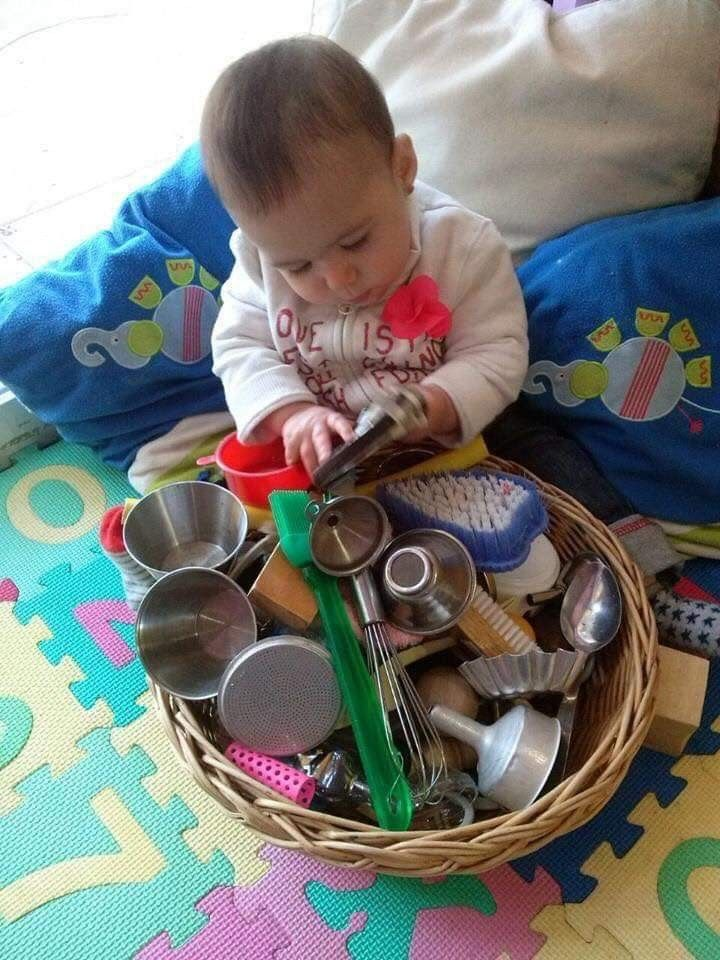
plastic containers for presenting small loose parts
Ziploc bags for presenting small loose parts
bottles with screw on lids for presenting small loose parts
trays to present small parts on
cookie cutters
paper towel rolls
boxes and tins (tissue boxes, baby puffs containers)
ribbons of various widths, lengths and colors
napkin rings
silicone scrubber brushes
dish scrubber brush (or any kind of soft hair or paintbrush)
ice cube tray
spatula
funnels
disposable water bottles
uncooked rice, beans, macaroni, and popcorn
sponges
wooden spoons
fabric (different textures and colors)
dish cloths
Plastic scrubbies
DOWNLOADABLE PDF LOOSE PARTS LIST
A note on safety: of course, since loose parts and sensory items aren’t manufactured toys you need to make sure you’ve got your safety hat on. Make sure bottle and container lids are screwed on tightly and check this regularly.
Baby should always be supervised closely when engaging in loose parts play, particularly when first introducing them to the items. Your baby will explore the objects in ways that you never thought of and what may be safe one minute can get worrisome the next. For example, when I first gave Weston a paper towel roll he banged it on everything and yelled into it for some time, which was great! But once he started to eat it, not so much.
HOW DO I INTRODUCE & ENGAGE MY BABY IN SENSORY LOOSE PARTS PLAY?
A little bit at a time! This is a good rule of thumb generally speaking with kids. Show baby only 3-6 items at once. They’re bound to get overstimulated and overwhelmed if they have too many items at a time (this is also true with regular toys).
Provide baby with 3-6 items to play with at a time to avoid overstimulation and keep them focused rather than overstimulated by too many things.
Introducing Playthings with Your Baby
At around 7.5-weeks-old I was carrying my daughter around the house when I noticed something - she had grabbed on to my shirt. The next day, she was laying on the floor in our bathroom and grabbed our shower curtain. While these seem like little moments, it's actually a really big deal to me! Through this observation, I can see that my daughter is getting ready for more active work for her hands.
Brand new babies are born with a reflexive grip, called the palmer reflex. Their hand is not closing around items specifically of their own will. Sometimes the palmer reflex is mistaken for an intentional interest in holding onto playthings for early babies - I know I definitely have made this mistake in the past. But, we don't really know if they want to hold on to those items or not. Slowly over the months following birth, babies reflex will weaken and more intentional grasping will take over.
One of the first signs for me, that some intentional grasping is happening is when babies, start grabbing things that aren't purposefully placed into their hand - especially cloth around them.
Montessori Approach to Introducing Toys to Newborns
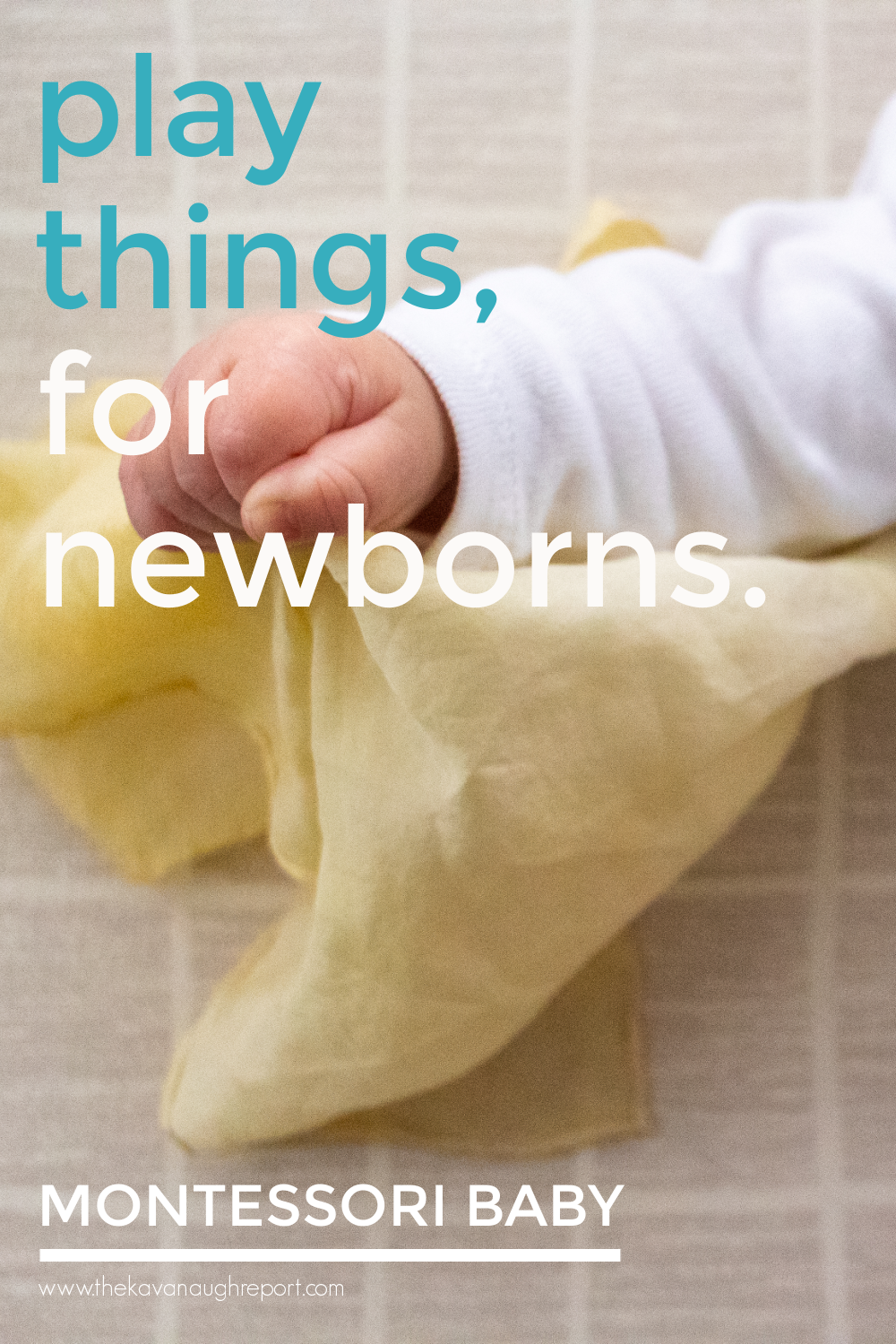
A Montessori approach to introducing toys to newborns often looks like this: a choice of 2 toys is held in front of a baby; they are given the opportunity to look at both. Whichever the baby looks at is then placed close to or in the baby's hand. The baby then reflexively grasps and explores the material. Often this could look like holding it for a few seconds (then often dropping) or might look like holding it in their hand without a lot of other exploration.
I think this is a perfectly fine way to introduce playthings to a new baby. And, I personally find that I use this technique more and more as my babies gain control over their hands, and arms. However, for brand new babies, this isn't a technique I've been following anymore. I think it can sometimes lead adults to placing things in a baby's hands that they do not have the strength or desire to explore yet. Things can sometimes slip onto a baby's body or face, or are just a nuisance as a baby is trying to explore their body. Instead, with a older baby, I have found the RIE approach to be more inline with these early grasping days.
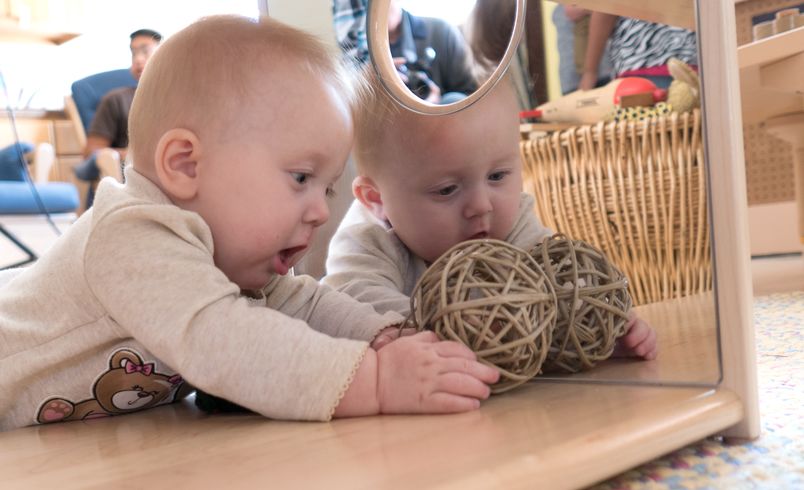
RIE© Approach to Introducing Loose Parts to Older Babies
The Montessori approach is not the only way to choose to introduce materials to a new baby. RIE, or Resources for Infant Edu-carers, is another way I hold close to my heart for babies. And, instead of placing materials in a baby's hands or within their reach, RIE, places the materials in the infant's environment, then the baby is free to explore as they discover them. In my RIE training, I learned that tented fabric is often a great place to start for new babies. It's easy to grasp and safe to hold on to. Other materials can also be placed around the infant's environment to explore as they gain more control over their bodies. Downside here is that if baby doesn't find the material in their environment, they don't get that experience with it.
With my daughter, this is the approach I have taken. I used a small play silk (but cotton cloths work great too) to make a small "tent" in her play area. Then I place them within her reach. If her hand finds the cloth, she may or may not interact with it. She may feel it, push it, grasp it, pull it - she has the freedom there to explore as much as she is able and interested. At this point I might also put a wooden ring, or soft ball near her as well but not place them directly into her hands.
Again, I don't think one method significantly outweighs the other when it comes to newborns and playthings. Engaging baby in sensory and loose parts play can be tricky, because you may be tempted to show them how to do things, but you also want to let them discover things on their own. Wait for a lull in their play and inspire baby with something new, such as stacking containers, flipping something upside down, or making a sound by banging objects against one another. They’ll often copy you and try to see if they can manipulate the items in the same fashion.
Set up play activities and encourage exploration by playing together. Stack containers, flip something upside down, or make a sound by banging objects against one another. They’ll often copy you and try to see if they can manipulate the items in the same fashion.
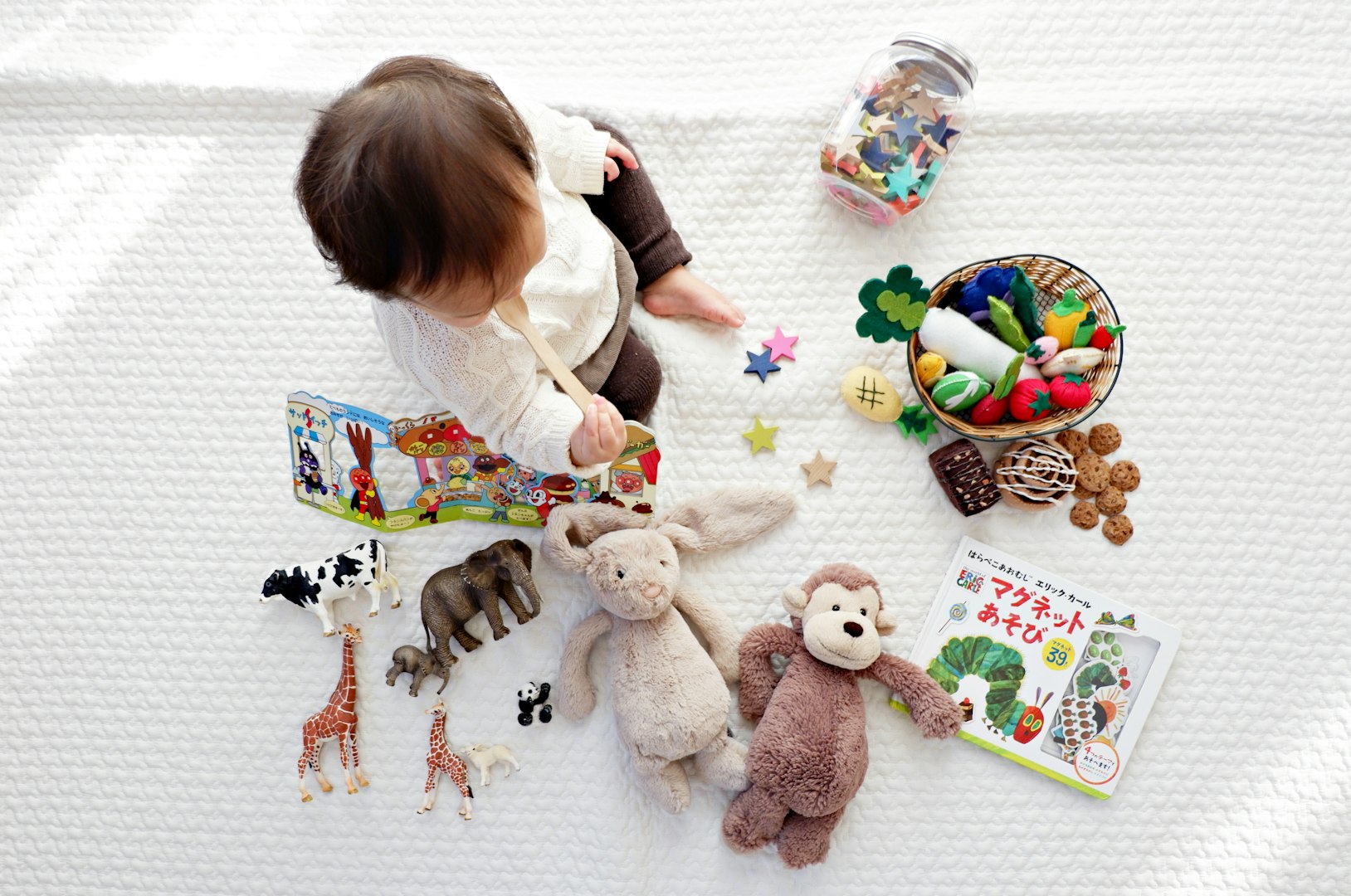
Babies are curious about everything in their surroundings, and you may well find that they are drawn to the strangest objects. Also, they may start to show that they have some favorite objects, even at this stage, and it is good for them to experience these open-ended play objects many times. This reinforces their prior learning and begins to link their past with the present.
When buying toys, consider how many ways they can be played with before purchase and what that material is helping your child develop and explore. For example, little figures, animals, cars, or people are fantastic for imaginative play.
Unique blocks are my absolute favorite loose parts because they offer endless possibilities. Just because you have loose parts in your home and engage in sensory play certainly doesn’t mean baby can’t enjoy traditional toys as well.
Loose Parts Play Ideas for Young Toddlers
In this post, we will explore loose parts play ideas for young toddlers, including a range of different resources to use. Loose parts play is a fantastic way for early toddlers to explore as they begin to develop interest and fascination on their own. Their interactions become more and more like a open-ended play experience so children can create and play with a wild range of different objects. It is child-paced and self-directed, so the young toddler is more self driven and starts creating their own experiences.
Toddlers love to fill, dump, and carry things, so provide materials to support these interests, such as coasters, large glass stones, rocks, postcards, and scarves. Also add materials with interesting properties that can be used for design or construction, or made into props. Natural, found, and upcycled objects such as seashells, stones, tiles, ribbon, and fabric are some examples.
Loose parts are materials that can be moved, carried, combined, redesigned, lined up, and taken apart and put back together in multiple ways.
They are materials with no specific set of directions that can be used alone or combined with other materials. You'll find our loose parts collection offers many different objects, of all shapes, sizes and textures to excite and spark children's imagination and sensory learning. All objects are eco friendly and you won't find any plastic here!
Loose parts play is terrific for children of all ages, though with toddlers, you have to be careful about supervision and the loose parts used, as they tend to put things in their mouth and throw things. I would not recommend anything made with glass or tiny parts that children could choke on. What is safe for one child might not be safe for another. Please consider carefully the appropriate supervision and the individual behavior and needs of any child that would be playing with loose parts and any toys.
Examples of loose parts play
Children can use loose parts in a wide range of different ways. They may use them to make art, build, engineer, tell a story, role play, a combination of these and more.
Some examples of children’s loose parts play include children using sticks for any of these creative purposes: as a spoon in their play kitchen, to build a fort or den, a sword for a fight, as a magic wand, to draw in the dirt, as ‘candles’ in a ‘cake’, as a flag pole on a sandcastle, to bang pots, float it in water, or perhaps it can be broken into pieces, made into a pile, and much more. Children might use rocks to represent spices, medicine or money in their play. Other possibilities are stacking them on top of each other to make towers or using them to create a picture or pattern.
It can be great to give children loose parts to explore and experiment with on their own. You can also add in loose parts to play areas such as mud kitchens or construction areas to help take their play further. One day a play kitchen can be used for water play and to support learning about measurement, pouring and mixing. The next day it can be filled with colorful chickpeas and then be used for sensory play, sorting, or scooping. Another day children can use scissors, flowers and leaves which they can use for cutting, chopping and mashing. My children have also used our mud kitchen to help construct tents with wood planks, cloth and pegs to create an ice cream parlor or coffee shop.
It can also be lovely to set up trays for children to explore different materials and use various tools. I usually set out a range of different materials, but we also have a lot of resources such as tools, play materials, etc. that the children can get for themselves. For example, while I may have set out water, pots, containers and flowers for them to play with, my children might decide to get scissors and a colander so that they can cut and mash the flowers.
Take it further – Loose parts play ideas
for early toddlers
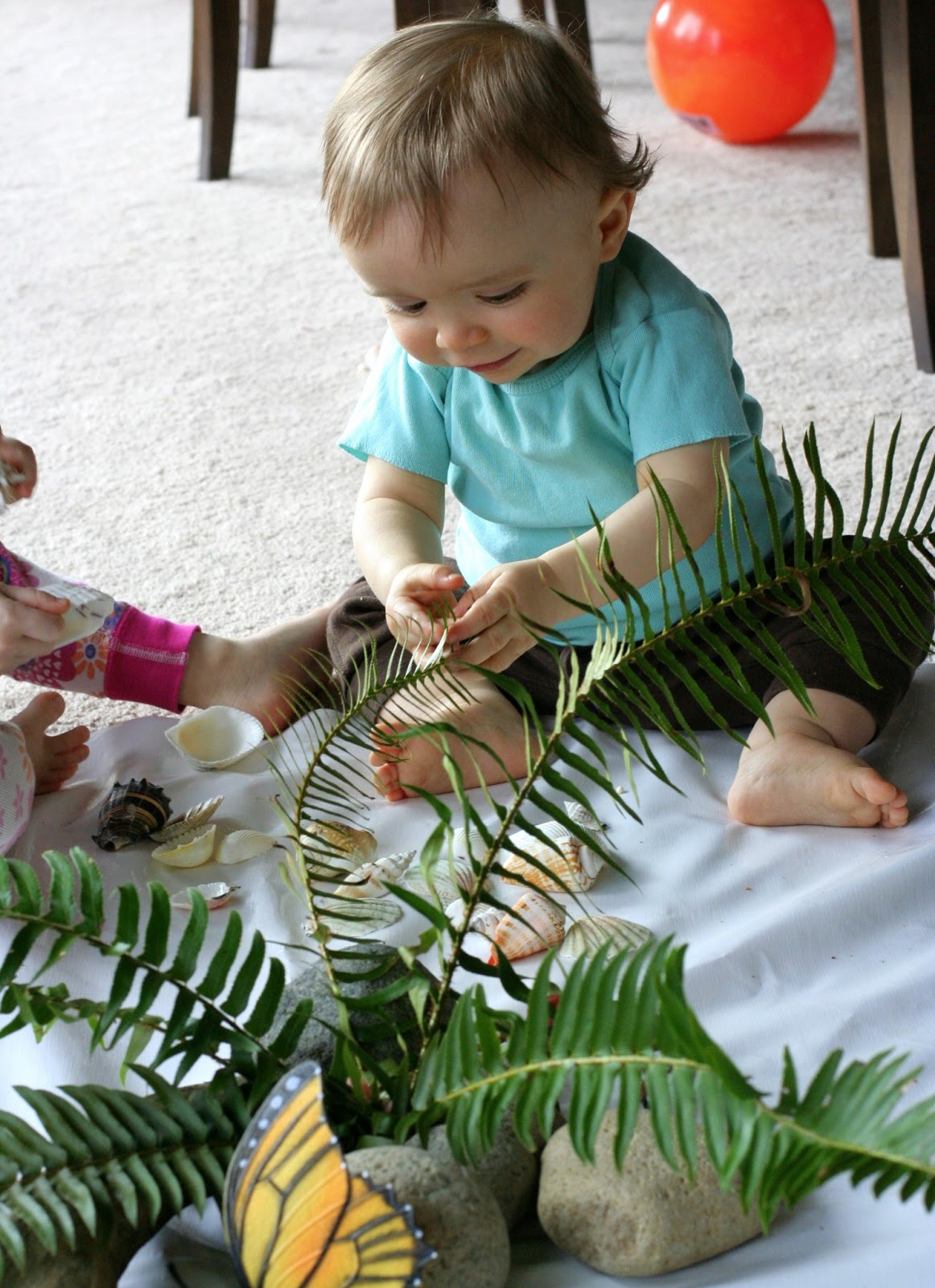
Loose parts play is an opportunity for open ended play.
Children can explore on their own, or adults can play alongside them to help extend their play by asking them questions or playing along with them.
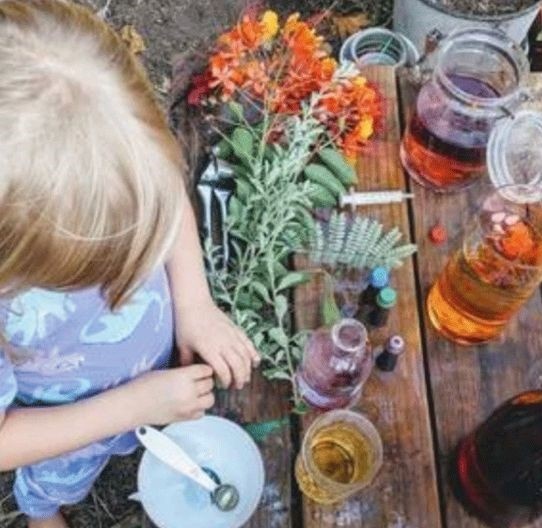
Superscript
Loose Parts for Toddlers And Above
To introduce loose parts to toddlers, start with large, safe items and introduce them one at a time in a designated space, like a treasure basket or divided trays, to help them understand the materials. You can provide inspiration by modeling how to use them, such as by placing them on sticky tape on a wall or pressing them into playdough. Gradually introduce more variety, considering different textures and aesthetics to encourage sensory exploration.
This video provides ideas for introducing loose parts play to toddlers:
Start with the basics
Begin with large items: Start with larger objects that are not choking hazards, such as wooden blocks, large plastic cups, or fabric scraps.
Introduce one type at a time: Begin with just a few types of loose parts to avoid overwhelming your toddler. A good starting point is 3-5 options.
Use "treasure baskets": A treasure basket, which is a basket with 4-10 different loose parts, is a great way to organize and present the materials.
Create an inviting play space
Organize the materials: Display loose parts in divided trays, individual bowls, or baskets to encourage thoughtful play and respect for the materials.
Make it accessible: Keep the materials at your toddler's eye level so they can easily access them.
Encourage and guide their play
Model how to use them: Show your toddler how to use the loose parts by pressing them into playdough or arranging them on sticky tape on a wall or high chair tray.
Involve them in collecting: Go for walks to collect natural loose parts like acorns, sticks, and rocks. You can also ask them to help you find safe household items to use.
Add sensory variety: Incorporate items with different textures, like cotton balls, rough wood cookies, or smooth metal pieces, to provide a rich sensory experience.
Expand as they get comfortable
Introduce more variety: Once they are comfortable, you can slowly introduce more items, rotating them out as needed.
Consider different themes: Organize loose parts based on themes like color, texture, or sound to give new ideas for play.
Play Schema And Loose Parts
Play schemas are patterns of repeated behavior that all children use to explore and understand the world, while loose parts are open-ended materials that support schema play. For example, a child with an "enclosing" schema might use loose parts like blocks or blankets to build fences or hide things, while a child with a "trajectory" schema might use loose parts like balls to practice throwing and watching how they move. Loose parts provide the materials for children to act out their innate urges and learn through hands-on exploration.
This video explains the importance of loose parts play and provides examples of materials that can be used:
Understanding play schema is essential to setting up creative loose parts play
Schema: A schema is a pattern of thought or behavior that organizes children's knowledge and actions, often seen as repetitive behaviors that help them make sense of their world.
Loose Parts: These are materials that can be used in many different ways, providing endless possibilities for creativity and problem-solving. Examples include natural objects like stones and sticks, recycled materials like cardboard tubes, and manufactured items like blocks and beads.
Examples of schemas and how loose parts support them
Enclosing Schema: Children who are enclosing are fascinated with creating boundaries and defined spaces.
Schema in action: Building a fence with blocks around toy animals or drawing a circle on paper around an object.
Loose parts support: Provide blocks, small fences, or even blankets to build enclosures or to put objects inside containers.
Trajectory Schema: This is seen in children who are interested in movement, particularly throwing, dropping, and the path of objects.
Schema in action: Throwing balls or dropping objects from a height.
Loose parts support: Offer balls, buckets, and containers for pouring, and a safe space to throw objects at a target.
Positioning Schema: Children with this schema like to line things up, sort, and stack objects in a specific order.
Schema in action: Lining up cars in a row or stacking blocks one on top of another.
Loose parts support: Provide a variety of small objects that can be sorted and arranged, such as buttons, pebbles, or beads, to make mandalas or ten frames.
Enveloping Schema: This is the urge to cover something or oneself completely.
Schema in action: Wrapping an object in fabric or covering every inch of a paper with paint.
Loose parts support: Provide fabrics, boxes, or playdough to hide and cover objects.
Connection Schema: Children with this schema explore how things connect, link, and fit together.
Schema in action: Connecting blocks or building bridges.
Loose parts support: Offer materials like tubes, pipes, string, or magnetic tiles to create connections.
You can watch this video to learn how to identify different play schemas in children:
Using play schemas to plan loose parts play involves observing children's repetitive play behaviors and then intentionally providing materials and environments that support and extend those interests. This approach allows for a deeper understanding of children's learning processes and helps guide their development.
Steps to plan play using schemas:
Observe and Identify Schemas:
Carefully watch children during their free play.
Note recurring actions or patterns, such as lining up objects (positioning), filling and emptying containers (enclosing/transporting), throwing or dropping items (trajectory), or building and connecting (connecting/enclosing).
Recognize that these repeated actions are not random, but rather evidence of a child exploring a particular concept or idea.
Provide Schema-Supporting Resources:
Once a schema is observed, offer a variety of open-ended materials and resources that allow children to explore that schema further.
Examples:
Enclosing: Boxes, baskets, fabric, building blocks, playdough, loose parts for creating boundaries.
Trajectory: Ramps, balls, soft objects for throwing, slides, water play with spray bottles.
Connecting: Interlocking blocks, puzzles, tape, glue, string, craft materials.
Positioning: Loose parts like pebbles or shells for lining up, stacking blocks, beads for creating patterns.
Adjust the Environment:
Make small, intentional changes to the play space to encourage schema exploration.
Examples:
Add tunnels or cozy spaces for children interested in enclosing.
Set up areas with ramps or targets for trajectory play.
Create a "fort building station" with blankets and pillows for enclosing.
Engage and Extend:
Participate in the play alongside the child, narrating their actions and asking open-ended questions to deepen their exploration.
Introduce slight challenges or new materials that extend the schema, encouraging them to take the "next step" in their learning. For instance, if a child is consistently stacking blocks, introduce different-sized blocks or encourage them to build a bridge.
By intentionally planning and supporting play based on identified schemas, educators and caregivers can provide rich, meaningful learning experiences that align with children's natural developmental interests.
To plan loose parts play, gather diverse materials, set up an engaging space, and facilitate exploration with minimal intervention. Start with a small selection of open-ended items, introduce new parts intentionally over time, and observe how children use them to inform future planning.
This video explains the basics of loose parts play and provides tips for getting started:
1. Gather your loose parts
Collect a variety: Aim for a wide range of materials that offer different textures, colors, and sensory experiences.
Mix natural and man-made: Use items from nature like sticks, stones, and pinecones, as well as man-made objects like bottle caps, buttons, and corks.
Source materials creatively: Ask friends and family to contribute, have children bring in a few small, safe items from home, or purchase items like glass gems or mini erasers.
Consider safety: Always assess for choking hazards based on the age of the children involved. You can introduce larger, more durable items first before adding smaller, more fragile ones, as noted by My Teaching Cupboard.
2. Create an inviting play area
Choose a location: Set up an area indoors or outdoors, such as a block center, dramatic play area, or a math and science center.
Present materials intentionally: Displaying loose parts in divided trays, bowls, or baskets can suggest their value and encourage more thoughtful use, say My Teaching Cupboard and Kathy Brodie.
Make it open-ended: The goal is to create an "invitation to play" that encourages exploration rather than a specific outcome.
This video demonstrates how to set up a loose parts play area:
3. Facilitate and observe
Start with observation: Allow children time to explore the materials freely and discover their own uses.
Provide minimal guidance: Avoid telling children what to create. Instead, model simple ways to use the materials or ask open-ended questions if invited into the play, advises Teach Early Years.
Rotate and reflect: Intentionally rotate the materials to keep them fresh and introduce new possibilities. Use observations to plan future play experiences.
4. Adapt to the children's interests
Follow their lead: Use loose parts to support a child's current interests. For example, instead of a plastic toy, blocks can be used to build a farmhouse, a castle, or a house, according to the YouTube video.
Integrate with other activities: Add loose parts to other areas, like a Play-Doh tray to create small worlds or into sensory bins.
Tips for Incorporating Loose Parts in Preschool Play
Jan 13, 2025 — Tips for Incorporating Loose Parts in Preschool Play * Examples of Loose Parts: Recycled items: Buttons, bottle caps, ...
Mar 13, 2022 — To set up an invitation to play with loose parts, you can: * Decide which loose parts to offer * Choose a learning are...
Loose parts boost a child's creativity quickly by providing open-ended, unprescribed materials that encourage them to use their imagination, problem-solve, and think outside the box. By manipulating objects like stones, sticks, or cardboard tubes, children can create their own scenarios, develop new ideas through trial and error, and express themselves in unique ways, fostering creative confidence.
How loose parts boost creativity fast
Encourage imagination and open-ended play: Unlike toys with a single function, loose parts can be anything a child imagines—a stone can be a telescope, a car, or a building block. This freedom allows them to develop original ideas rather than following a prescribed use.
Promote problem-solving and critical thinking: Children must figure out how to balance stones, connect pieces, or build structures, which encourages them to think critically, experiment, and find their own solutions.
Foster cognitive flexibility: Handling loose parts teaches children to see different uses for the same object and to approach tasks from various angles, leading to more innovative outcomes.
Provide endless possibilities: Loose parts can be combined in countless ways, preventing boredom and providing a continuous source of new challenges and creative opportunities.
Support self-expression and confidence: When children are in control and can build, deconstruct, and create their own scenarios, they develop confidence in their own ideas and abilities.
Enhance language and social skills: Children often describe their creations, explain their ideas, and negotiate with peers, which builds language skills and encourages teamwork and social development.
Examples of loose parts to get started
Natural items: Stones, sticks, pinecones, shells, leaves
Recycled materials: Cardboard tubes, buttons, bottle caps, fabric scraps, egg cartons
Household items: Jar lids, wooden spools, keys, small boxes, kitchen rollers
Craft and building supplies: Craft sticks, beads, pipe cleaners, marbles
10 Ways to Play with Water Beads
{Sensory Summer}
I say this every year but I CANNOT believe how fast summer has flown by! We have really loved having all of our sensory summer bins to look forward to each morning, and will be taking a few weeks off before starting our regular “school”… [read more]
10 Ways to Play with Water and Ice {Sensory Summer}
I think my girls would live in their swimsuits all summer long if I let them. My little fishies sure do love water play so I was excited to plan a few activities to spice up our normal water play. Here are our 10 ways… [read more]
10 Ways to Play with Sand {Sensory Summer}
What kid doesn’t LOVE playing in the sand. Well I have a confession…I kind of hate sandboxes. And yes we have one in our backyard, but I’m a bit OCD and there’s something about sand that drives me insane. I mean it gets eve-ry-where! My… [read more]
10 Ways to Play with Cereal {Sensory Summer}
I’m not sure why I’ve never filled our sensory bin with cereal before, but it made the perfect taste safe bin for my girls. They loved measuring, mixing, dumping, scooping, and snacking every time I took our bin out to play. Check out all 10… [read more]
10 Ways to Play with Magnets {Sensory Summer}
What kid doesn’t love exploring with magnets? Other than our magnet letters we really haven’t played too much with magnets together. So I ordered some magnetic wands and this week’s Sensory Summer theme was all about magnets! If you want to gather all of your… [read more]
10 Ways to Play with Paper {Sensory Summer}
This fall I filled our sensory bin with shredded paper for the first time and discovered that it was a really fun, engaging, (and easy!) sensory bin filler. So this week’s Sensory Summer bin was filled with….paper! I chose red, white and blue for our… [read more]
10 Ways to Play with Cloud Dough
{Sensory Summer}
This week’s Sensory Summer bin was filled with….Cloud Dough! We love this stuff for so many reasons! It’s ridiculously EASY to make (8 cups flour + 1 cup veg. oil) It’s taste safe (not yummy, but safe!) It has a smooth and fluffy texture but… [read more]
10 Ways to Play with Pouch Lids {Sensory Summer}
Confession: I’m a pouch lid hoarder…Anyone else with me? I don’t know about you but we go through food pouches in this house like crazy, especially in the summer when we are always in the car needing quick and easy snacks on the go. This… [read more]
10 Ways to Play with Rocks {Sensory Summer}
It’s rock week! Do your kids insist on gathering rocks everywhere they go like mine? I mean we literally cannot cross a parking lot without scooping up like 7 little treasures that they just HAVE to have. So we spent all week gathering the piles… [read more]
10 Ways to Play With Pool Noodles
{Sensory Summer}
I remember as a kid we literally were not allowed inside the house except to eat, sleep, and use the bathroom in the summertime. Here in New York we only get a few months of truly hot summery weather, so we really have to make the… [read more]
Natural Materials for Loose Parts Play
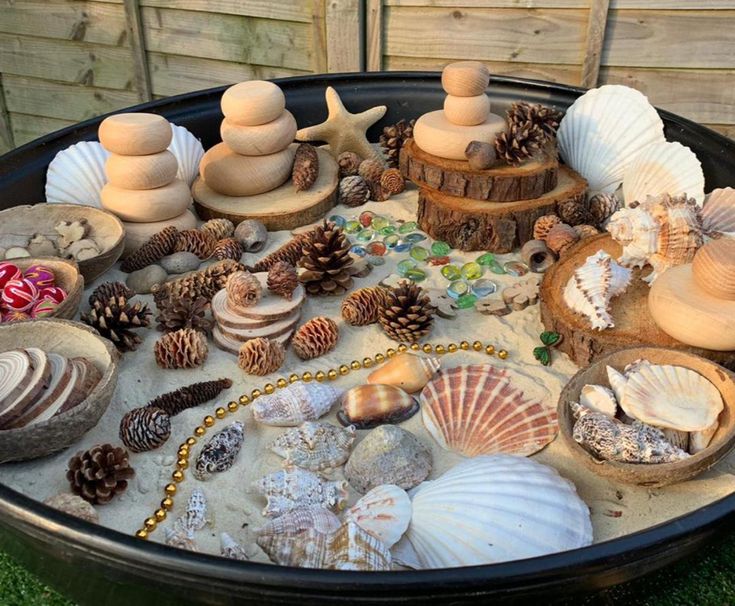
In Early Childhood Education, loose parts are a manipulative toy which can be used in open ended play. Loose parts can be anything at all, and they can be used in an endless number of ways. I love to use natural materials in our loose parts play, and it has become somewhat of a collection for me. Now I look at anything in my home and hoard it in our loose parts box before throwing it away.
Loose parts that are derived from nature can be multi-sensory. This means that they stimulate more than one sensory system. A natural loose part can be stimulating to your sense of sight, smell, taste, sound and touch. Let’s use a pinecone as an example. Visually, you can observe the natural spiral pattern that it makes. You can stamp it in play dough and notice the spiral impression that it makes. You can notice it’s earthy smell, and feel its small prickly sides.
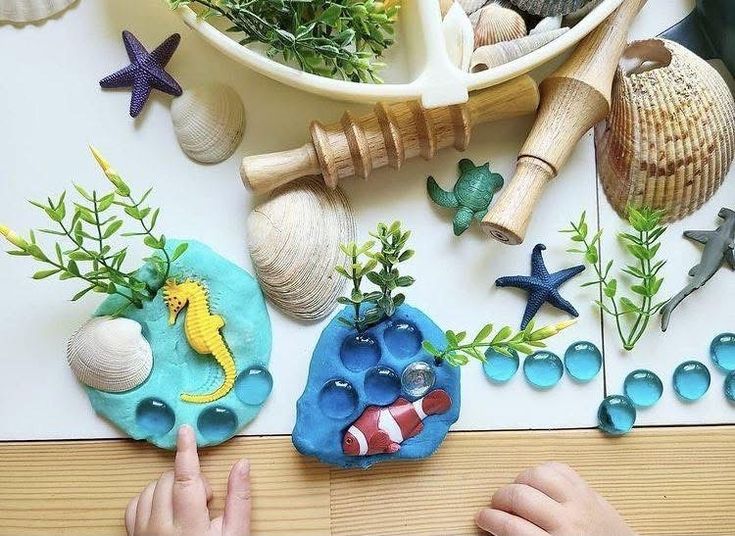
With the loose parts that nature offers, children can construct their own adventures. They can balance, jump, and scamper using their whole bodies in ways that support their kinesthetic development (Sobel, 2008). When children create a coastal scene or a woodsy playground such as a forest, the loose parts are already there for pretend play or storytelling. When adults want to create adventure outside for children, they can also supply and use natural loose parts without restraint because Open-Ended Materials Belong Outside Too! I love this free downloadable resource that will support the use of loose parts outdoors for adventure play!
Explore, Create, Play with Loose Parts!
As the babies and toddlers learn to play and interact with the loose parts with their own self-directed ideas, we can start presenting the loose parts in new ways. Setting up a loose parts activity station can be a creative and engaging way to encourage open-ended play and exploration, especially for children. Loose parts play is fun for all ages! Loose parts are open-ended materials that can be moved, combined, redesigned, and tinkered with in various ways.
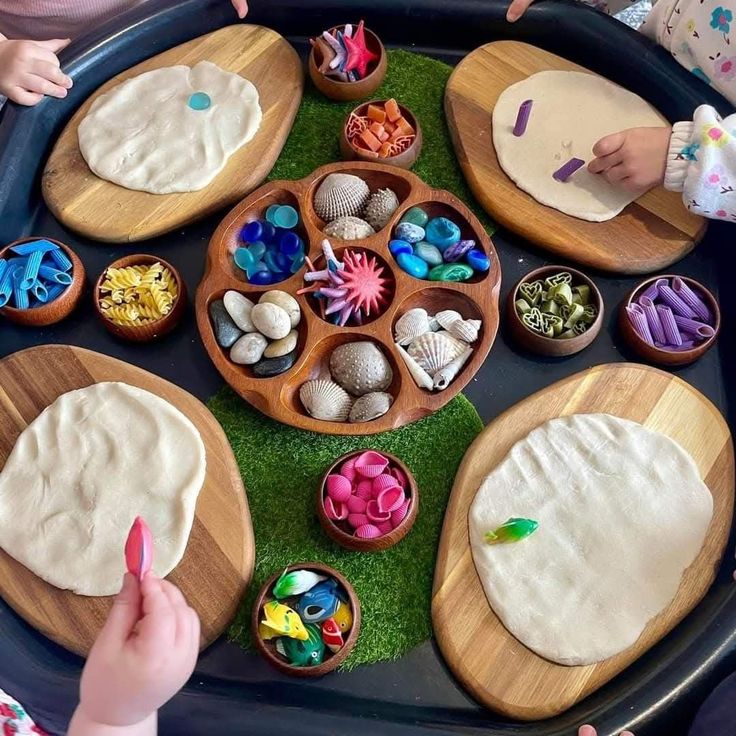
What do you do?
Choose a Location: Select an appropriate location for your loose parts station. Make sure it's a safe and easily accessible area.
Gather Loose Parts: Collect a variety of loose parts that are safe and interesting. These can include natural materials like sticks, leaves, pinecones, rocks, and shells, as well as recycled or repurposed items. The key is to provide a diverse range of materials that spark creativity and imagination. You may also use brown paper bags to collect your own loose parts!
Organize and Display: Organize the loose parts in containers or baskets. Consider using containers that are easy to reach and handle, especially for young children.
Encourage Exploration: Emphasize the open-ended nature of the loose parts station. Encourage children to experiment, create, build, and invent using the materials provided. Let them know there are no right or wrong ways to play.
Facilitate Play: While loose parts play is largely child-directed, you can occasionally participate to inspire ideas or ask open-ended questions. For example, "What can you create with these materials?" or "How can you use these items to build something?"
Foster Collaboration: If multiple children are playing at the station, encourage them to collaborate and share ideas. This can lead to cooperative play, problem-solving, and imaginative scenarios.
Document and Celebrate: Consider documenting the creations and play scenarios that children come up with. Take photos or notes. This can inspire others and celebrate the children's creativity. Remember, the goal of a loose parts station is to promote open-ended play, creativity, problem-solving, and critical thinking. By providing a variety of materials and fostering a supportive environment, you can create a space where children can explore, experiment, and learn in their own unique ways.
What do you need?
Baskets or containers
Loose parts- Can include sticks, leaves, pinecones, shells, rocks, feathers etc.
Optional: Magnifying glasses, measuring tapes to enhance exploration
Safety Considerations:
Ensure that the materials provided are safe for the age group using the loose parts station. Avoid small parts that could be a choking hazard, and make sure any tools are appropriate for the children's age and skill level.
Benefits:
Intellectual Benefits: Creativity and imagination is explore. The open-ended nature of the materials fosters imaginative thinking and the ability to see possibilities in various combinations. Manipulating and combining the loose parts requires problem solving. Loose parts play promotes critical thinking as individuals assess the properties and potential uses of various materials. Playing with loose parts involves concepts like shape, size, symmetry, and counting. These interactions with materials can help develop early mathematical skills.
Spiritual Benefits: Incorporating natural materials into loose parts play can foster a sense of connection to the natural world, promoting a deeper appreciation for the environment and the beauty of the outdoors. Engaging with loose parts can encourage mindfulness, as individuals focus on the process of play and exploration. Loose parts can be used to create symbolic representations of ideas, stories, or emotions, providing a way to explore and express deeper thoughts and feelings.
Physical Benefits: Handling and manipulating different materials requires precision and control, contributing to the development of fine motor skills and hand-eye coordination. The varied textures, weights, and temperatures of loose parts engage the senses, providing sensory-rich experiences that can be both stimulating and soothing.
Emotional Benefits: Loose parts play offers a nonverbal means of self-expression. Individuals can convey their emotions, thoughts, and ideas through the creations they build. The absence of right or wrong ways encourages a positive self-image and can boost self-confidence. If done in groups, collaborative play promotes teamwork, negotiation, and communication skills. The tactile and creative nature of the play can have a calming effect.
Loose Parts and Playdough
For those that like to use playdough with loose parts... sensory nature play dough recipe made using herbs, rose petals and flowers to scent and colour the dough. Might be nice to add in to play with natural loose parts like dried flower petals, sticks, shells, grass ect You can also enhance the sensory experience by adding loose parts like beads or sand directly into the dough or by incorporating natural elements like spices or essential oils for scent.
Loose parts can be used with play dough to encourage creativity, fine motor skills, and imaginative play by providing open-ended materials for decoration, building, and sensory exploration. Examples include pressing small objects like beads or shells into the dough to make imprints, adding items like googly eyes and pipe cleaners for decoration, or using household items like straws and bottle caps as tools for cutting and stamping.
For creative and imaginative play
Decorate and build: Use items like beads, buttons, and gems to decorate play dough creations, such as making cupcakes or adding texture to animal figures.
Create scenes: Provide loose parts like small toy animals or rocks to create a story or a miniature world within the play dough.
Make different textures: Mix in natural items like leaves, shells, or pinecones to add unique shapes and textures to the dough.
For fine motor skill development
Press and push: Encourage children to push small objects like beads, pasta, or even nuts and bolts into the play dough. This strengthens the small muscles in their hands and fingers.
Imprint and shape: Use items like stamps, buttons, or small animal figures to press designs and imprints into the dough.
Cut and manipulate: Offer recycled items like marker tops or the ends of straws to use as cutting and molding tools.
As a "treasure hunt" or discovery activity
Hide and find: Hide various loose parts within a ball of play dough and have children find them, or bury them and let them dig to uncover a "treasure".
Match and sort: Use loose parts like colored counting bears or colorful beads to hide and then have children find and sort them by color or type. This video shows how to make a classic playdough recipe:
Ideas for enhancing your playdough
Add loose parts: Mix decorative items like directly into the dough to create unique textures and colors, as shown in this YouTube video.
Create scented dough: Knead in a few drops of essential oil or herbs into the playdough has cooled to add a calming or invigorating scent.
Use natural colors: Incorporate natural colorants like turmeric for yellow, paprika for orange, or spirulina for green.
Add textures: Mix in fine sand to create a "sand playdough" for a different sensory experience, as seen in this recipe on Mama.Papa.Bubba.
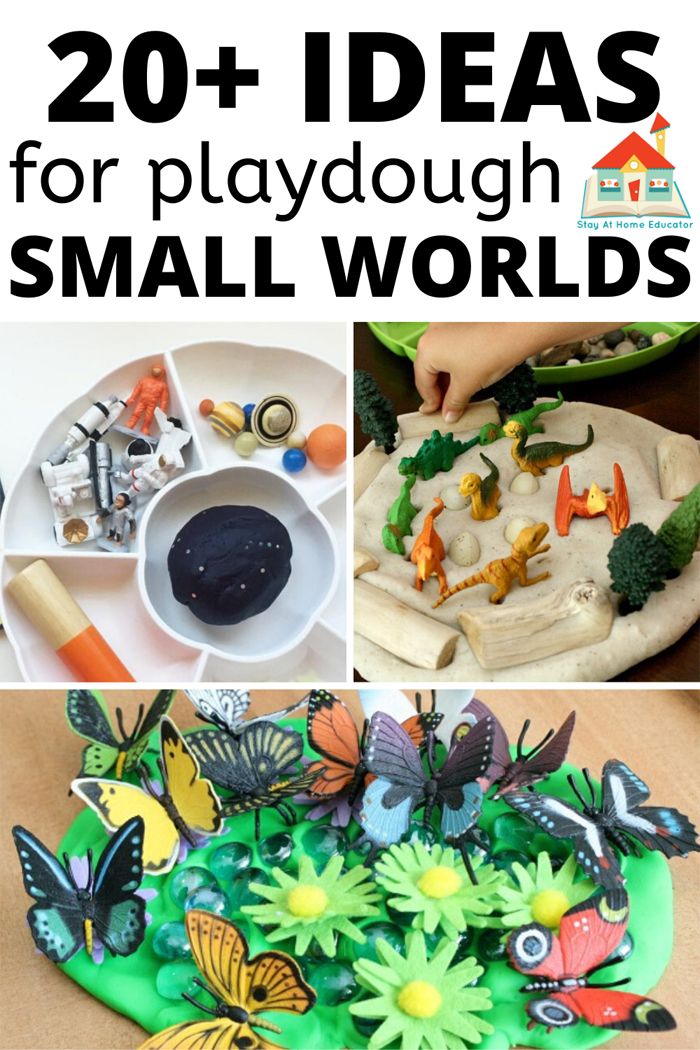
20+ Playdough Invitations to Play
Are your kids getting bored with the same old playdough activities? If so, then you’ve come to the right place. This blog post is all about fresh ideas to rekindle their interest via playdough invitations to play. Grab your favorite playdough recipe and get ready!
Using Loose Parts Play for Language and Vocabulary Building
As you observe and encourage your children in loose parts play, you will see how naturally it lends itself to early literacy skills. Whatever age or stage of development your child is in, loose parts play will support the process. The most important indicator of a successful reader and writer is a child who develops a love for literacy early on. This is sure to happen when children have ample opportunities to read, be read to and most importantly, to play.
Loose play parts can be used to develop speech by encouraging children to describe objects, label their creations and even narrate their interactions which will in turn expand vocabulary and improves conversational skills. By letting children discover how to become a part of the conversation around materials like blocks, buttons, or natural items, they will become comfortable in engaging more deeply and build language in a meaningful context in the process.
Superscript
Loose Parts Play Ideas for Children
In this post, we will explore loose parts play ideas for toddlers, including a range of different resources to use. Loose parts play is a fantastic way for toddlers to explore and develop. It is open-ended play so children can create and play with a range of different objects. It is child-led and self-directed, so children are in charge.
Loose parts play is terrific for children of all ages, though with toddlers and babies, you have to be careful about supervision and the loose parts used, as they tend to put things in their mouth and throw things. I would not recommend anything made with glass or tiny parts that children could choke on. What is safe for one child might not be safe for another. Please consider carefully the appropriate supervision and the individual behavior and needs of any child that would be playing with loose parts and any toys.
Examples of loose parts play
Children can use loose parts in a wide range of different ways. They may use them to make art, build, engineer, tell a story, role play, a combination of these and more.
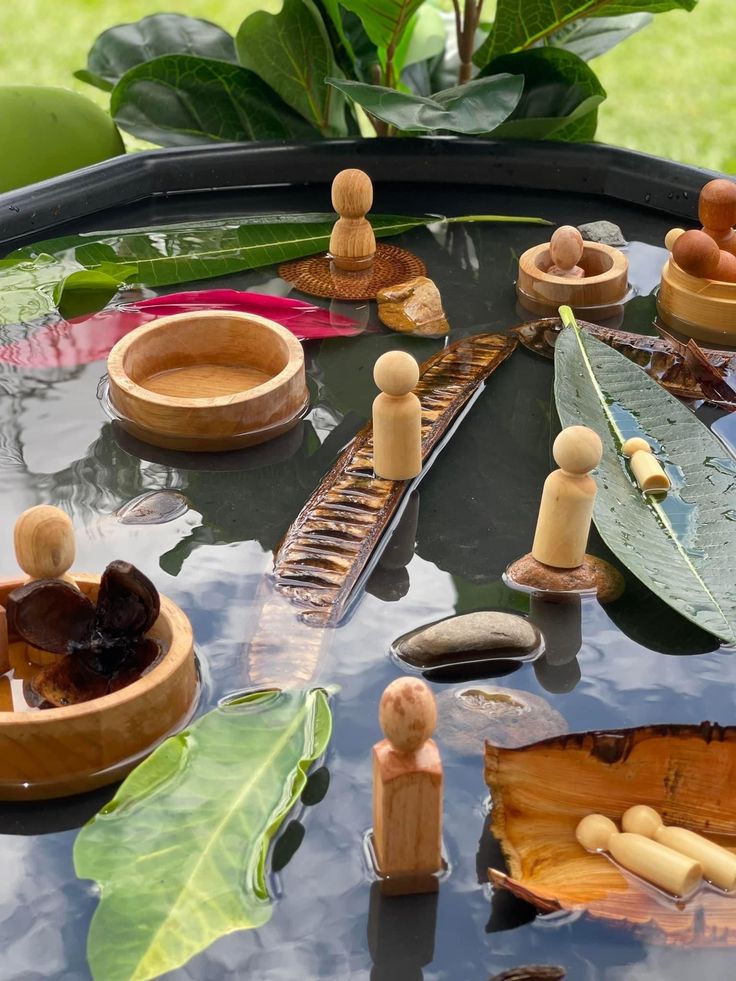
Some examples of children’s loose parts play include children using sticks for any of these creative purposes: as a spoon in their play kitchen, to build a fort or den, a sword for a fight, as a magic wand, to draw in the dirt, as ‘candles’ in a ‘cake’, as a flag pole on a sandcastle, to bang pots, float it in water, or perhaps it can be broken into pieces, made into a pile, and much more. Children might use rocks to represent spices, medicine or money in their play. Other possibilities are stacking them on top of each other to make towers or using them to create a picture or pattern.
It can be great to give children loose parts to explore and experiment with on their own. You can also add in loose parts to play areas such as mud kitchens or construction areas to help take their play further. One day a play kitchen can be used for water play and to support learning about measurement, pouring and mixing. The next day it can be filled with colorful chickpeas and then be used for sensory play, sorting, or scooping. Another day children can use scissors, flowers and leaves which they can use for cutting, chopping and mashing. My children have also used our mud kitchen to help construct tents with wood planks, cloth and pegs to create an ice cream parlor or coffee shop.
It can also be lovely to set up trays for children to explore different materials and use various tools. I usually set out a range of different materials, but we also have a lot of resources such as tools, play materials, etc. that the children can get for themselves. For example, while I may have set out water, pots, containers and flowers for them to play with, my children might decide to get scissors and a colander so that they can cut and mash the flowers.
Benefits of loose parts play
There is growing evidence to show that there are many benefits to loose parts play for children. It provides opportunities to support creativity and concentration and to develop motor skills and hand-eye coordination. It is also beneficial for developing language and literacy skills and social and emotional skills. It can enhance cognitive abilities, social and emotional development, and mathematical and scientific thinking (Wells, 2000; Daly and Beloglovsky, 2015; Maxwell, Mitchell and Evans, 2008).









